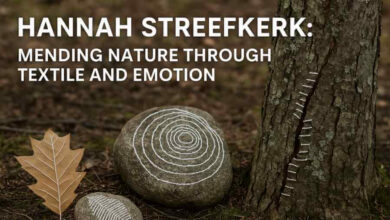Erin Robinsong: A Voice of Ecological Imagination and Poetic Reckoning

Erin Robinsong is a poet and interdisciplinary artist who writes from the threshold between language and world, between self and other, and between the human and the more-than-human. Her work is rooted in what she calls “ecological imagination” — a mode of attention that seeks to dissolve the hardened boundaries separating nature from culture, feeling from thought, body from environment. Over the past decade she has become an important figure in contemporary poetry, both for the daring formal strategies of her writing and for her commitment to rethinking how art might respond to ecological crisis.
Early Life, Formation, and Intellectual Roots
Erin Robinsong grew up in Cortes Island, on Coast Salish Territory, in a rural setting that seeded her earliest intimacies with land, water, and non-human life. From that land-rootedness she later migrated—intellectually and geographically—into cities: Montreal, London, Toronto, and elsewhere. In doing so, she has sustained a poetic sensibility that holds the tension between wilderness and the civilized, between dislocation and belonging.
Academically, she pursued an interdisciplinary path. Currently she is a PhD candidate at Concordia University, where her research-creation work focuses on regenerative, relational, and embodied poetics. Her scholarship draws on feminist environmental philosophy, ecopoetics, and theories of relationality, and she is invested in how poetic language might open onto other cosmologies — not those inherited from Enlightenment separation, but those reimagined from more-than-human worlds.
Major Works and Projects
Rag Cosmology (2017)
Robinsong’s debut full-length poetry volume, Rag Cosmology, was published by Book*hug and won the A. M. Klein Prize for Poetry. In this collection, she reorients cosmology away from grand geometric order and instead toward a lived, porous, mutable sense of relation: “everything is moving,” she implies, and nothing is truly static.
The poems of Rag Cosmology resist conventional form, using fragmentation, spatial play, shifting perspective, and lyric rupture to enact a poetics of relationality. As one reviewer put it, she writes a kind of “eco-eroticism” — a feminine consciousness in resonance with the world’s flux. The environmental concerns in the volume are often implicit and avoid overt moralising, instead provoking readers to feel and sense complicity.
Liquidity (2020, chapbook)
Robinsong’s chapbook Liquidity further deepened her engagement with water as metaphor, medium, and agent. Though shorter in length, Liquidity maintains her interest in permeability, flow, and the porous borders of subjectivity. Throughout her oeuvre, water is not merely a motif but a partner in thought: a way to destabilise solidity, to reorient language toward the wet, the shifting, the liminal.
Wet Dream (2022)
Her most recent major collection, Wet Dream, was published by Brick Books in 2022, and likewise garnered the A. M. Klein Prize. In this volume, the stakes of ecological crisis sharpen. Her poetic voice pulses with urgency, eroticism, grief, and defiant tenderness. Sea, air, animals, decay, dream, and consciousness swirl together. The title itself suggests a radical possibility: the dream as wet, mobile, entangled.
The poems in Wet Dream are charged with vitality; they don’t wait for permission to speak. They confront necrocapitalism, species loss, pollution, mourning, while evoking the possibility of repair, intimacy, and relational aliveness. Critics have described the work as a “pulse of agency to the heart” — a book that lives in the tension between despair and renewal.
Collaborative Project: Return Address
In collaboration with the biologist and writer Merlin Sheldrake, Robinsong undertook a project called Return Address, which gathers poems addressed to ocean, air, plants, rocks, and creatures. The project asks: what happens when we address the world, rather than speak about it? This shift from representation to address is a gesture toward relational accountability. Over a workshop on Cortes Island (2023) and various public engagements, they invited participants to craft poems or “letters” to non-human beings and to experiment with interspecies perception and communication.
Return Address is, in many respects, a poetic experiment in ethical listening and relational imagination — a complement to her more canonical collections and a window to her interdisciplinary and activist sensibility.
Key Themes & Aesthetic Strategies
Ecological Imagination & Relational Being
Central to Robinsong’s work is the idea that our present ecological crisis is also a crisis of imagination. If we continue to think of nature as an “other” — separate, objectified, exploitable — we perpetuate violence. Her poetry works instead to dissolve boundaries, to cultivate relational being: bodies are always already in relation with air, microbes, soil, water, species, geological time.
In Rag Cosmology, the self is never autonomous: it is porous, responsive, permeable. In Wet Dream, the breathing, the tides, the molecular contact of bodies and elements are foregrounded. She often uses minimal punctuation, interruptions, enjambment, and visual layout to unsettle the reader’s expectation of closure.
Listening, Sound, and Biophony
Robinsong is deeply invested in sound and listening as an ecological practice. In an interview with Bernie Krause (bioacoustician and soundscape ecologist), she explored how listening to soundscapes gives access to temporal dynamics, species interaction, habitat health, and ecological loss. Poems in her oeuvre often evoke breath, vibration, interior resonance, and ambient hum — inviting readers to internalise an acoustic ecology.
The Erotics of Entanglement
A notable feature of her poetry is the erotic register: desire, intimacy, sexual metaphors, flesh, moisture — these are not gratuitous but woven into her ecological vision. Eroticism becomes a vector for tenderness, contact, rupture, and rebounding connection. In Wet Dream, desire is also a way to feel politics: to feel with what is vulnerable, threatened, alive.
Power, Coloniality, and Aesthetic Resistance
Robinsong does not shy away from the politics embedded in language. She is attentive to settler colonialism, extractivism, the violence of separation, and the regimes of thought that underpin ecological crisis. By bending form, resisting the master tropes of lyric self, and privileging relationality over individualism, she performs resistance. In interviews, she has critiqued hierarchical power in institutions, noted the precarity of artistic life, and affirmed the necessity of political freedom in poetic practice.
When collaborating in dance, she and her collaborators have attempted non-hierarchical payment structures, rotating roles, and shared power dynamics.
Poetic Process & Spatial Thinking
Robinsong often reflects on the spaces where she writes: from minimal, “bare” rooms to rented or borrowed sites, from reading rooms in London to residencies in Banff, and from alleyways and porches to the forested edges of her home island. She trusts that the qualities of space—light, air, temperature, presence of plants or animals—shape her attention.
She has described switching between inside and outside: gathering material in the more spontaneous, unpredictable mode of the outdoors; then bringing that into interior rooms of concentration, editing, transformation. She emphasises that each location produces a different logic of perception.
She also honours drift, interruption, surprise, and rupture as integral to her method. These are not cosmetic strategies but condition of perceiving in complexity. The poem may explode, shift, rupture; it is not a vessel to be filled but a field of relations to attend.
The Stakes Today: Why Erin Robinsong Matters
In an age of climate breakdown, mass extinction, and epistemic erasure, poets like Robinsong offer more than aesthetic solace: they summon alternative modes of relation, attention, and worldmaking. Her voice invites readers to slow, to lean in, to listen with care, and to sense connections that are too often disavowed.
For younger poets, her work offers a model: rigorous, risky, impatient of easy closure; committed to not just speaking about crisis but living within it, probing its seams. For ecological thinkers, she injects poetry into conversation, insisting that scientific and political imaginations alone cannot respond to the fullness of our predicament. For general readers, her poems offer new ways of being in a world where limits are visible and fragility is no abstraction.
Moreover, her emphasis on collaboration, shared power, place-based pedagogy, and embodied listening suggests that art must not be isolated, but engaged, porous, implicated.
Challenges & Critiques
No practice is without tensions. Some readers may find her fragmentation difficult to follow, or desire more concrete anchors of place or species. Her resistance to exposition or overt explanation means that some poems do not yield immediate clarity, which can test patience. In Rag Cosmology, critics have wondered whether the more abstract register risks evaporating specificity.
But these are intentional choices: Robinsong’s refusal of overt explication is part of her poetics of uncertainty, of wonder, of listening rather than dictating. The challenge to the reader is part of the invitation — to slow, to yield, to feel rather than control.
Selected Poems & Readings
-
“Vibration Desks” (from Rag Cosmology) plays with urban and natural juxtapositions, layering tree bark, clouds, a woman speaking into a rectangle.
-
“The Woods” evokes longing and fragmentation, ending with spatial naming: “pine fir yew” — naming the forest, naming intimacy.
-
“Places to Intervene in a System” (published on Watch Your Head) evokes collapse, human chains, extinction, and the stubborn persistence of voice. Her Return Address workshop poems, addressed to seeds, soil, water, offer experimental instants of contact and address.
Hearing Robinsong read is also a potent experience. In a reading of Rag Cosmology, her voice becomes an instrument — the silences, the intonations, the breathing shape the poem as much as the text.
What Readers Can Do: Engaging with Robinsong’s Poetics
-
Read slowly and aloud. Her poems often unfold in time; attending to sound and breath reveals textures that mere scanning misses.
-
Allow ambiguity. Not every poem will resolve. Stay with tension, let the edges remain rough.
-
Listen ecologically. Consider how your own reading inserts you into a field of beings — language, air, microbes, other readers.
-
Write response poems or addresses. Try addressing a plant, an insect, or landscape; borrow her technique of shifting from speaking about to speaking with.
-
Attend performances or readings. Robinsong’s interdisciplinary sensitivity means that in performance (with dance, sound, space) new registers emerge.
-
Pair with ecological theory. Reading alongside thinkers in ecological philosophy, postcolonial ecology, or feminist environmental theory can deepen the resonance.
Concluding Reflection
Erin Robinsong is not merely a poet of nature — she is a poet of relation, of adjacency, of listening. Her work insists that we cannot remain at a distance from the world; we are always implicated, entangled, vibrating. In the age of climate unraveling, she offers a poetics that is not safe or consoling, but necessary.
If we can attend to her poems, not merely for their lyric beauty but for their ethical charge, we may emerge less isolated, more porous, more open to the trembling wonder of a living world. That is both her gift and her demand.



